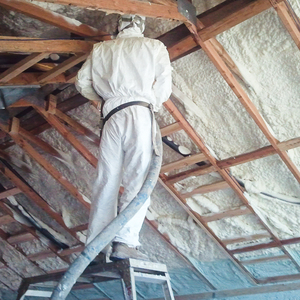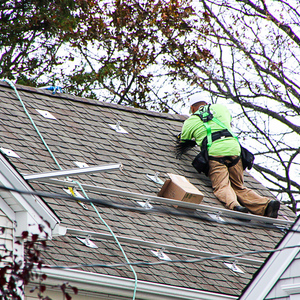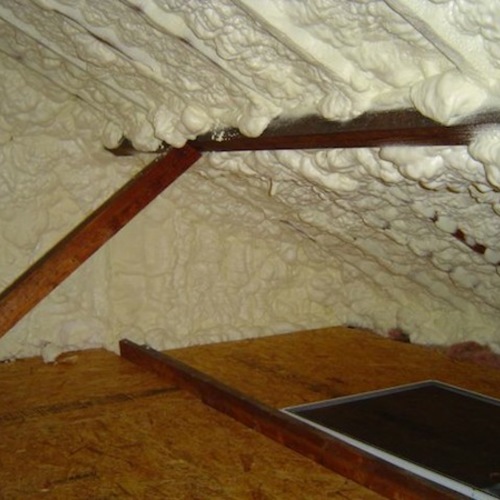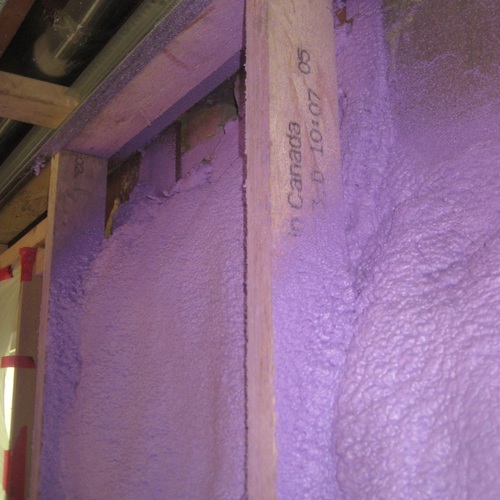
Spray foam is a great tool for insulating and weatherizing. It can be applied to horizontal and vertical surfaces. Once it is cured, it can be the air barrier and vapor and thermal control layers (at least closed-cell foam can), and it provides some of the highest R-values per inch available. It slices! It dices! It makes great sushi!
Well… it does have some drawbacks. Since spray foam is a fossil-fuel-derived product, its green benefits are hotly debated. Its tremendous utility comes at a price: all flavors of spray foam are costly compared to other types of insulation. Citing health reactions to the product, some customers have filed a class-action lawsuit against foam manufacturers.
Lastly, installing the product is tricky.
Thermoset polymers and you
Spray foam insulation is a thermoset polymer. For those of you without an advanced chemistry degree (or those, like me, who haven’t yet read Wikipedia), a thermoset polymer is a heat-activated plastic polymer. It usually starts in a liquid or malleable solid form; through chemical curing, it assumes a solid form.
Spray foam insulation of the sort we’re discussing here is made from two chemical components; when these components are mixed, the foam heats up rapidly and cures into a solid form. This seemingly straightforward process can be problematic, especially when the insulation is installed in cold weather.
Spray foam shrinkage and other fun
The manufacturers of spray foam are a pretty meticulous bunch. The technical specs are pretty clear, detailing the proper temperature ranges and substrate conditions. (The substrate is the surface being sprayed.)
Although most installers are top-notch, there can be issues. Cold weather can play hell with foam applications, leading to the most common problems: shrinkage and poor adhesion to the substrate.
Spray foam is a two-part polymer. The two components are referred to as the ‘A’ and ‘B’ components. Improperly mixed foam is a fairly common problem that can occur in any climate. In this article, we’ll look at challenges that are specific to a cold climate.
Minimum substrate temperatures
The surface onto which the foam is sprayed needs to be within the manufacturer’s specified range. An important note here is that we’re talking about the substrate surface temperature, not the ambient air temperature. Most spray foam manufacturers spec a surface temperature range between 60°F and 80°F. An uninsulated wood sill on a very cold January day could easily get below 60°F. Hell, it would probably get below 45°F.
This problem can easily be sussed out with a simple laser thermometer. You should check the actual temperature of the surface that will be sprayed. When applied to an overly cold surface, the final foam cure can be gummy and shrink away from the edges.
Component temperatures
Spray foam rigs are large temperature-controlled trailers. The two-part component tanks are stored in these trailers, which maintain an appropriately warm temperature. The components must be maintained at a specified temperature range, just like the surfaces that will be sprayed.
When one or both components are off temperature, the mix can be off, affecting the final foam set. The application may end up not adhering well. If it is ‘A’-rich, it will end up crunchy and fibrous; if it is ‘B’-rich, it will be gummy and pliable. None of this is good.
Ice and moisture on the substrate
If you’re insulating a modern foundation wall — one made of formed concrete — then XPS foam board may be an option. But older rubble or brick foundations need to be spray foamed. It’s very common for these foundations to have heavy moisture levels; in some cases, they can be freezing. If ice has formed on the spray surface, and the ice was sprayed over, there will be no connection between the substrate and the foam. Once the ice melts, the foam could pull off the surface. Another “not good.”
Spray foam is one tool used by insulation contractors and energy auditors to address house problems. Spray foam works; just be aware of the effects that cold weather can have on it.
Erik North, the owner of Free Energy Maine, is an energy auditor and home performance specialist in Westbrook, Maine. He is also the author of the Energy Auditing Blog.
Weekly Newsletter
Get building science and energy efficiency advice, plus special offers, in your inbox.















2 Comments
Substrate Conditions
Erik, I'm a little confused. You cite the need to the substrate to be at least 60 degrees F and later observe that if there is ice on the substrate there may be problems with adhesion. What are the ill effects of spraying on substrates between these two conditions?
Check the Specs
There is no set number for the substrate temperature. SPF manufacturers can create systems that are formulated to spray to substrates well below 60°F. Clearly, the warmer the substrate, the better the foam reaction, but temperatures greater than 60°F is not a requirement. Check page 4 of this TDS for example: http://tinyurl.com/p6jngve.
Log in or create an account to post a comment.
Sign up Log in